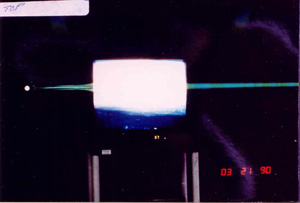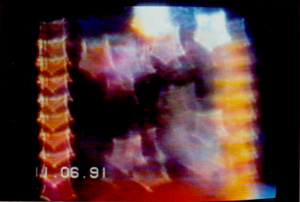INSTRUMENTAL TRANSCOMMUNICATION
by Ernst Senkowski
back to TOC
B-12.5 ANALYSIS OF TRANSIMAGES
Analytical studies of transimages shall be restricted to those cases in which – same as with the disturbed acoustic signals (S/N in Ill. 22) - more or less clear structures are recognizable in the optical noise (snow), or in the patterns of light and dark (FRISBY).
The subjective impressions drawn by different observers from what is identically offered to all of them, depend on the ‘quality’ of what is offered (S/N ratio), and on the observer’s psychic situation at that time, including the attention paid to specific areas of the screen. The co-acting scleromorphic, and rheomorphic unconscious inner psychic structures remain in the background.
Vague ‘images’ appear as individual constructions of individual observers, they remain ‘hidden’ from the others, and, even with suggestive help, cannot be traced by others. Where clearer shapes have come through, the exchange on the subjective impressions can lead to intersubjective consensus. The number of images that are ‘objective’ in the sense of being immediately recognized and described in a consistent manner, is by far less.
These reactions are sufficiently known from psychological tests (e.g., RORSCHACH), as well as the turn-over effects, in which the same (graphic-)optical structure can be ‘seen’ or interpreted in two ways. In recent years N.E. THING ENTERPRISES published under ‘The magic eye’ several bestsellers showing pictures in whose almost periodical structures are tucked away pictures of plastical appearance, that can only be perceived with a specific adjustment of the eyes/consciousness. This new variation of the game ‘I see something that you don’t see’ can be conceived as a step towards a multidimensional consciousness, and towards the perception of other realities, a step unconsciously accomplished by sundry millions of people.
The meaning and/or importance of several particularities of the transimages is unclear. Repeatedly, the blending-ins commence with one (or a few) black pictures. The effect reminds of the ‘Blackies’, which - despite of the camera being open within a bright room - appeared with Ted SERIOS’ mental projections on photographic material before defined motives became apparent. In at least one case, which occurred at HOMES, the structure of the optical ‘noise’ (snow), till immediately before the appearance of a short freezing frame sequence, was distinctly different from the immediately following one.
|

Ill. 26: PHOTOGRAFIC EXTRA:
GREEN LIGHT RAY
ERLAND R. BABCOCK - USA
|
Within the scope of his TV experiments in the audiovisual laboratory of the Lowell University, BABCOCK intended to photograph in the darkroom a scene visible on the screen. The photo (Ill. 26) shows left of the apparatus, on its horizontal line, a light source of about the size of a dot, which is surrounded by an annular appearance (of interference?). From this point of start, a slender green light ray extends towards the screen, accompanied by two weaker collateral rays. In front of the screen, this bundle of rays disappears, but becomes visible again on the right side, and is almost periodically sequenced in longitudinal direction by lighter and darker cross strips. While taking the photo, BABCOCK did neither perceive the light source, nor the green ray. |
|

Ill: 27: TRANSVIDEO-IMAGE:
COMPLEX COLOURED STRUCTURE
ADOLF HOMES - BRD
three more images |
A further rarity constitutes the 24 sec. long coloured sequence of pictures recorded by HOMES on June 11th, 91 (single picture Ill. 27). Between two structures resembling vertebral columns, can be seen, near the right and left picture borders, complex patterns that vary in form and colour, and resemble pentagonals. While the left column has relatively sharp contours right from its beginning, the initially fuzzy right one becomes clear only towards the end of the sequence. In some individual pictures faces or figures can be rather surmised than recognized. The indications to ‘scalar fields’ and the formation of the transimages, in this context mediumistically received via F. SCHNEIDER from CLAUDIUS/TESLA, are merely partly understandable (F-37.10). Without knowing anything of this sequence of pictures, KLIMKE , on August 10th/11th, 1993, transmitted - in a relatively long text referring to the transmission difficulties - the unusual word ‘Strukturleiter’ (structure ladder): |
There exist overlapping electromagnetical interferences. Here with us, work is done (we work) with energy. Now, when it is a matter of determining the destination of the text transmission, equipment installations or persons, it may happen that sent out target couplings become doubled, if the dispatched structure ladders function almost identically in the information area, comparable, f.i., with a number 20571 or 20572, and these even along different directions. Then may occur an overlapping of the running across nodal points in the text. On your side you have frequencies in forms of strings, which are thought to lead to communication. If this frequently is inharmonious with other channels, (so) outsendings to destinations are disturbed, and what is transmitted does not arrive at all, or fragmented, or with other influxes of other information.
In France, several technicians have concerned themselves with the analysing of transimages. GUY-GRUAIS demonstrated that images that have formed by means of the feedback procedure contain partial structures which, after they were vertically halved, and their halves were mirror-reflected, appear as ‘faces’ of humans or animals. According to GRUAIS they could not have come about accidentally, nor could they be subjective interpretations - as is the case with RORSCHACH tests. It is rather suggestible to interprete them as projections from ‘parallel worlds’, or from different areas or levels/planes in the Beyond.
back to TOP November 2004
|
You are visiting our website: W rld ITC.org To reach our homepage click here please. rld ITC.org To reach our homepage click here please. |

